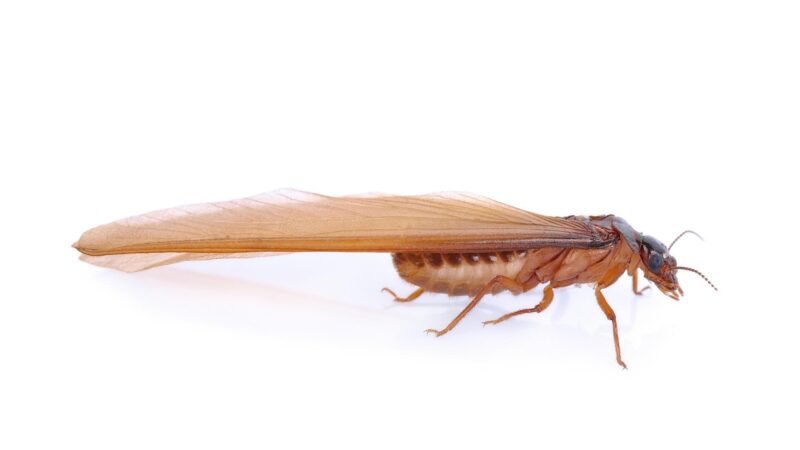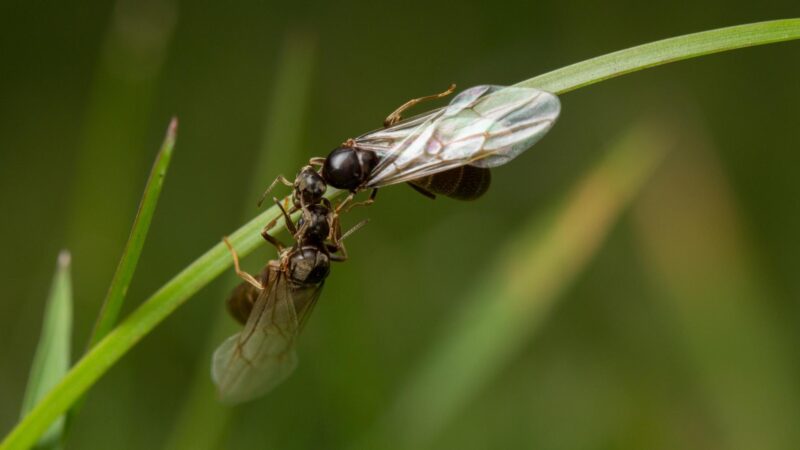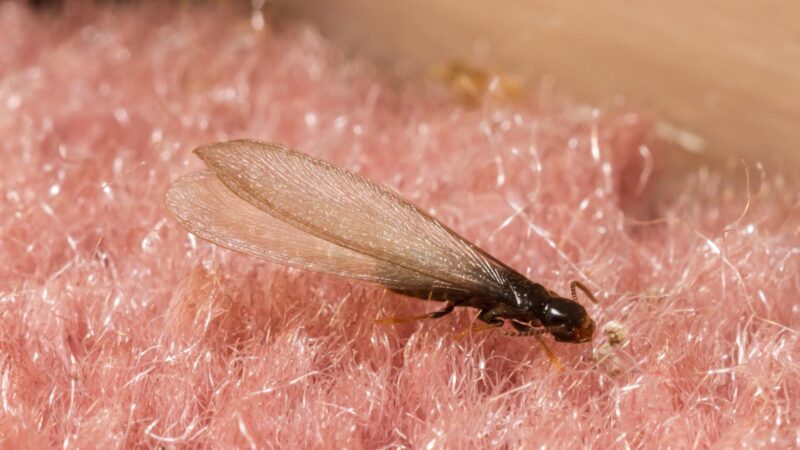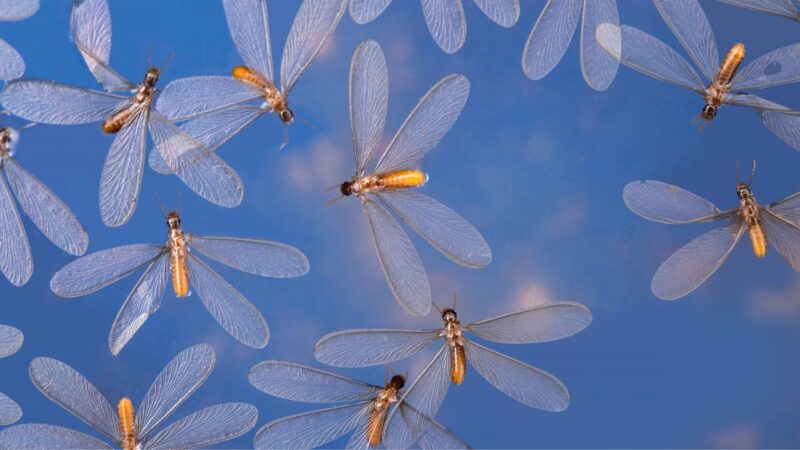Since termites feed on cellulose within the wood, no house is virtually safe from them. A termite colony has three important types of castes – soldiers, workers, and the reproductive ones called swarmers.
As the name implies, swarmers emerge or gather in large numbers or hover together as a group.
Do termite swarmers mean you have termites? The presence of termite swarmers means you have termites. But if they are found outside, it doesn’t necessarily mean that termites are already inside your house. If swarmers are in your house, a termite infestation is very likely to be happening for months now.
There are three common types of termites – dampwood termites (Termopsidae), drywood termites (Kalotermitidae), and subterranean termites (Reticulitermes).
All of them have swarmers, but they have different habitats and behaviors. This guide contains everything about termite swarmers and how to deal with termites.
What Are Termite Swarmers?

Termite swarmers are actually winged adult termites. They mostly came from a nearby nest and flew away to form a new colony.
Once these flying termites find a suitable place, they will land on the ground and will automatically lose their wings. These swarmers will find a mate and will soon be the next kings and queens.
What Do Termite Swarmers Look Like?
Also referred to as alates, termite swarmers look like flying ants. Aside from having four translucent wings of equal length, they have black or dark brown bodies, depending on the species.
These reproductive termites are about 4 mm long, with straight antennae but with no waist, abdomen, or thorax.
Termite Swarmer vs. Flying Ants

Termite swarmers and flying ants are almost lookalikes. But if you look closer, you will notice that flying termites have a very small or no visible waist, which means that their thorax is broadly joined to their abdomen.
On the other hand, flying ants have a narrow waist that connects their abdomen and thorax.
The length of the front and hind wings of flying termites are equal and are twice longer than their bodies, while the front wings of flying ants are significantly longer than their hind wings.
Another important difference between them is that flying termites have straight antennae while flying ants have elbowed antennae.
Are Termite Swarmers Dangerous?

Termite swarmers are not dangerous at all. They don’t bite or sting humans and pets. Despite being massive and looking scary, these harmless swarmers are not interested in people.
Their only purpose is to reproduce and start a new termite colony in a comfortable place. Swarming termites are also not great fliers.
Do Swarming Termites Cause Damage?
Swarming termites also don’t cause damage to wood and structures. Aside from being harmless, they are also not destructive pests. Termite swarmers are simply nuisances indoors and are also short-lived.
However, seeing only a few of these swarmers or some dead ones doesn’t mean you have no problem with termites.
What Causes Flying Termites in Your House?
The gradual rise in ambient temperature outside causes flying termites to enter your house. Termite swarmers are also attracted to light and homes with poor drainage systems.
Once they find a house where they can build a new colony, these winged termites will shed their wings on window sills or floors.
When Does Termite Swarming Season Start?
Termite swarming season starts in the early spring and usually lasts until fall, depending on the species. Subterranean termite swarmers appear from spring to summer months, Native subterranean termites appear during daytime hours, while Formosan subterranean termites swarm between dusk and midnight.
On the other hand, damp wood termite swarmers appear during summer and fall. Swarmers of some drywood termite species emerge from their nests in mid-spring or mid-summer, while some species appear in late summer or fall.
But interestingly, western drywood termites swarm between August and November.
Why Do Flying Termites Come Out After Rain?

Most flying termites come out after the rain because they are naturally drawn to moist and humid conditions. For them, the wet soil is an ideal place to breed and will help their nymphs survive longer.
Once the soil is moisturized, subterranean termites will find it easier to burrow underground, where they will lay eggs.
How Long Do Swarmer Termites Last?
Ideally, it would take 3 to 5 years before a termite colony will mature and be able to produce swarmers. Once these flying termites become kings and queens, they may live for a decade or more.
Those who cannot escape from your house quickly will die within only a few hours due to loss of fluids or dehydration.
Do Swarming Termites Mean Infestation?
Seeing swarming termites inside your house strongly suggests that there is already a termite infestation in or under your home. Note that it takes several years before these winged termites are produced.
If these swarmers are seen outdoors, the termite colony is most likely nearby or just around your yard.
Will Killing the Swarmers Solve the Problem?
Killing swarmers doesn’t solve a termite problem. As earlier mentioned, flying termites don’t cause damage to structures; they are only nuisances.
Once you kill them, you are only stopping them to start a new colony. Remember, it is the worker termites that cause problems, not the swarmers.
How Do You Get Rid of Termite Swarmers?
Again, termite swarmers will eventually die if they remain indoors and have lost their wings. But since they will start a new colony, you might also want to get rid of them at once.
However, harmful insecticides are not recommended for indoor use. Instead, here are some simple ways to get rid of termite swarmers:
- Since termite swarmers are not good fliers, you can easily hit them with a broom or a fly swatter such as Kensizer Heavy Duty Fly Swatters .
- Eco-Friendly - Premium PP material, harmless to your health....
- Flexible & Lightweight - It won't be broken off even make it bend...
- Durability - Non-slip thick handle helps you swat fly at a faster...
- Space Saving - Designed with hole, can be hung with the included...
- Quality assurance - You can get one replacement if they are all...
- Suck them with any kind of vacuum cleaner. Throw the vacuum bag far away to make sure they will no longer return.
- For termite swarmers on the window sill outside your house, you can also kill them with soap spray.
- Investigate where these flying termites came from. In doing so, you will discover their colony, which does the real damage.
How Can I Protect My Home From Termites?
Protecting your house from termites requires two important tasks – getting rid of termites that are already inside and preventing swarmers and worker termites from coming in.
But since termites usually hide in wood and soil, here are some useful tips on how you can find them and eventually get rid of them for good:
1. Look for pinholes on wood
Pinholes on drywall, ceiling, or other wooden structures strongly suggest that they are exit holes of termites. Also called kick holes, these tiny holes are usually created by drywood termites.
Subterranean termite workers rarely bore holes in wood since their nests are mostly under the soil but not connected to the wood.
In most cases, termites don’t intend to create these holes since they don’t like to be exposed. This is why you may notice some termites “repairing” them by putting mud on the surface. If there are only a few termites, you may sprinkle some HARRIS Food Grade Diatomaceous Earth to kill them on contact.
- Natural Product - Composed of 2lbs of 100% ground freshwater...
- OMRI Listed - Listed with the Organic Minerals Research...
- Powder Duster Included - Powder duster in the bag for easy and...
- Supports a Great Cause - Harris donates 10% of profits to support...
- Made in the USA – Mined in Nevada and packaged in Georgia
2. Look for mud tubes
Mud tubes are 1/4 – 1 inch in diameter and are made of saliva, dirt, and wood particles. These earth-hardened shelter tubes are made by subterranean termite workers to connect their underground nests to the foundation or interior of the house. Nevertheless, some tubes are not directly connected to wood structures.
Destroying them will not solve the problem since some termites could be hiding somewhere else. Once you break these mud tubes, you will see workers and soldiers crawling from or to their nests.
During swarming seasons, you may also see some swarmers emerging from them. If possible, throw away infested wood.
3. Look for damaged painted wall
Termites don’t eat paint, but they can damage painted walls. Check your wall for a sinking portion, peeling-off paint, or if it has some bubbles. In any of these cases, termites are likely to be overcrowded within the wall.
If the damage on the wall is somehow forming a straight line, it could be a path going to their colony.
Additionally, if possible, replace the infested wood structure and burn it outside. If there are only a few termites, try putting some cardboard bait traps.
Like wood, cardboards has cellulose, which termites are also attracted to. Once some termites are trapped, burn the cardboard outside and place another set of cardboard.
4. Check for sounds on walls
If the wooden wall has no damage outside, but you think that there are drywood termites inside, tap the wall lightly and listen very closely.
Termites cannot hear audible sounds, but they get bothered and threatened by the vibrations caused by sound. Once they sense your tapping, they will create sounds that you can hear.
In such a scenario, termites will bang their head on the wall to warn other termites about the potential danger. You may also hear some rusty sounds as termites try to move as quickly as possible.
But if you hear a hollow sound, it means that termites have already eaten your wall, and you need to replace them at once.
5. Reduce moisture
Since termites are also attracted to moisture, you may find them in moist areas, especially when the wood is connected to the soil. Whether or not you have termites, make sure your drainage is working properly.
To help reduce moisture, repair immediately those leaky pipes, air conditioning units, and cracks on exterior walls.
Remove firewood and stumps near your house, and replace them with rubber mulch or rocks. Note also that treated wood can be susceptible to termites in the long run.
If possible, use stainless steel in porches instead of wood. But more importantly, avoid wood structures from getting into direct contact with soil.
6. Conduct a probe test on the foundation
If you spot mud tubes going to your house, you should immediately check the foundation of your home. With the help of a flashlight, probe any wood, sill plates, header joists, or baseboard near your foundation using a screwdriver or ice pick. For better results, use the Prober Dry Rot and Termite Inspection Tool .
- CONNECTS TO ANY EXTENSION POLE - Female ACME threads allow you to...
- CHROME PLATED STEEL SHAFT - The steel shaft is durable and...
- BLUNT TIP - The rounded tip will not mark up sound wood like an...
- GLASS FILLED NYLON HANDLE WITH RUBBER OVERMOLD - The handle is...
If the wood has only little resistance against the probe, termites could already be present. Termites don’t eat cement, but they can squeeze their tiny bodies into cracks in concrete walls. To kill subterranean termites, treat the soil with granule termiticides such as BioAdvanced Termite Killer Home Perimeter Treatment .
- TERMITE KILLER: Easy to use granuals kills the termites you see,...
- PERIMETER DEFENSE: Treat around the perimeter of your home,...
- EASY APPLICATION: Just sprinkle, water, and walk away
- COVERAGE AREA: Treats up to 200 linear feet- that's the...
- RESTRICTIONS: Not for sale in NY, CT, CO, MD, VT & NJ
7. Install termite bait stations
Soil treatments or barriers are effective but require some concrete drilling at least 1 foot deep to ensure proper penetration. Alternatively, you may install termite bait stations such as BASF Advance Termite Bait System . Termites cannot see or smell the bait, which leads them to investigate and eventually discover them.
- Includes one CASE of TBS systems: 10 x Advance Termite Inspection...
- This bait system functions as a DETECTION tool, and does NOT...
- After termites are detected, replace with Trelona cartridges that...
- Does Not Include Spider Tool To Open It
Ideally, these pre-assembled bait stations should be installed underground around the house perimeter every 10-20 feet and about 2 feet away from the house.
Despite being a more eco-friendly method than pesticides, positive results may take months and with some luck. Therefore, patience is the key to success.
Related: How Much Does Termite Treatment Cost? | A Detailed Guide
List of Sources
Waldvogel, M., Alder, P. (2009). Termite Swarmers – What Do They Mean for You? NC State University.
Waldvogel, M., Alder, P. (2022). Termites – Biology and Control. NC State University.
Layton, B. Signs of Termite Infestation. Mississippi State University.
Potter, M. F. Protecting your Home Against Termites. University of Kentucky.
Chan, W. H., Pereira, R. M., Koehler, P. G. (2022). Drywood and Dampwood Termites. University of Florida.
- Bed Bug Surge 2025: How to Detect, Prevent, and Safely Eliminate Infestations in Top U.S. Cities - June 18, 2025
- Asian Needle Ants Invade US Homes: 2025 Guide to Identification, Risks, and Effective Control - June 11, 2025
- New World Screwworm Alert: How US Livestock Owners Can Prevent Outbreaks and Protect Herds [Summer 2025 Update] - June 8, 2025





